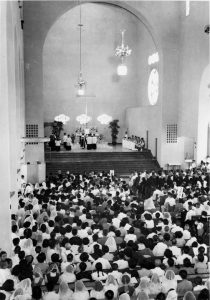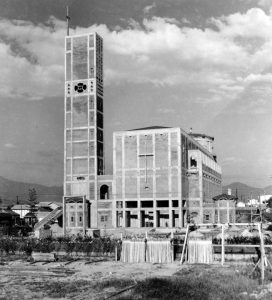Documenting Hiroshima 80 years after A-bombing: August 6, 1954, Memorial Cathedral for World Peace completed
Mar. 3, 2025
“Giving form to remembrance,” from Japan and overseas
by Michio Shimotaka, Staff Writer
On August 6, 1954, the Memorial Cathedral for World Peace was completed in the area of Nobori-cho (in Hiroshima City’s present day Naka Ward). Father Hugo Lassalle, who served as head priest of the Catholic Noboricho Church in Hiroshima and died in 1990 at the age of 91, devoted himself to the construction of the cathedral after he experienced the atomic bombing. The cathedral was a manifestation of his wish to eternally honor the victims of the atomic bombing. The inscription on the cathedral bell tower reads, “May all who come to worship at this church pray for the eternal rest of the victims and for everlasting peace among all humankind.”
On that day, after a religious dedication ceremony was held, a memorial service and completion ceremony took place at the cathedral, which was filled to its capacity of 2,000 people with worshippers. Japan’s Prince Takamatsu, who served as honorary president of the support association for cathedral construction because of his connection to an acquaintance of Father Lassalle, as well as diplomatic officials from 11 nations were in attendance the ceremony. A message from the Pope at the time was conveyed, stating that the cathedral served as a way to heal the wounds of war and as a symbol of the path to peace.
The cathedral, of reinforced-concrete construction, was designed by the architect Togo Murano. The cathedral measured 56.4 meters in height at its highest point including its cross. The height to the peak of the roof was 23.0 meters, enough space to accommodate a five-story building. The groundbreaking ceremony for the cathedral took place in October 1950. However, construction work on the building was suspended several times because of surging prices associated with the Korean War, which had begun in June that year, as well as material shortages. It took nearly four years until the cathedral was finally completed.
Names of 4,000 victims dedicated
Father Lassalle experienced the atomic bombing at his church. Contemplating the meaning of his survival from the bombing, he landed on the idea of constructing a memorial cathedral. He gained support for his idea from the Pope and adherents in Europe and South America, places he had visited in 1946 and 1947. He also received a substantial donation from a U.S. entrepreneur. Falling short of the necessary funds, however, he would visit companies in Tokyo, Osaka, and other cities by taking the night train and asking for donations in between busy periods of his church work.
Mr. Murano, recalling Father Lassalle, said, “Several times, I happened to find the tall priest sleeping in a corner of a third-class train car, his body bent and contorted,” in a description from the essay collection Ju-nin Hyaku-wa (in English, ‘Ten people, one hundred stories’), Volume 6, published in 1964. The architect was so impressed with the priest’s attitude that he declined any fees for design of the cathedral. The Shimizu Corporation, which built the cathedral, did its part to save on construction costs.
People in Hiroshima endorsed the aims of the construction communicated by the church, which were “to have the suffering and sadness [of those who died] serve as the foundation for world peace,” and provided their cooperation. They made offers of donations with an application form on which were inscribed the names of family members or friends who had in the atomic bombing or in the war. The names on the forms were transcribed into a directory known as the “Golden Book,” and were honored in a memorial Mass held following the cathedral’s completion. The number of names rose to around 4,000 people.
Shoji Fukabori, 87, a priest at the Society of the Light of the Gospel, located in Hatsukaichi City, who had attended the Catholic Noboricho Church, walked around houses in his neighborhood asking for donations, just as other churchgoers were doing. Many people were said to have supported the campaign despite not being Christian. Mr. Fukabori said, “I also heard people say, ‘if you have that kind of money, help me buy food.’”
Transcending religions
The cathedral construction was a major project in a society in which the scars from the atomic bombing remained and there was a lack of material affluence. According to minutes of a lecture he gave in 1983, Father Lassalle spoke of his gratitude for citizens and companies in Hiroshima, reporting how everyone had provided donations with an open mind and a global mindset despite not having much money. He added that everyone understood and recognized that the project would not fall within the range of a single narrow religion but had a universal meaning beyond religion.
A tabernacle, a pipe organ, and stained glass arrived from local governments overseas in Germany and Austria, nations that also had suffered severe damage in the war. Even after completion of the cathedral in 1954, installation of ornamental items continued, with the entirety of the work, including the installation of stained glass in the highest windows, finally being completed in 1962.
(Originally published on March 3, 2025)









